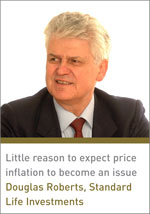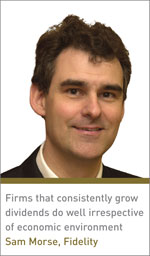What will be the major investment trends over the coming year in the US, Asia and Europe?
There will be a degree of compromise in relation to the US fiscal cliff, predicts Douglas Roberts, senior international economist at Standard Life Investments (SLI).
He believes that if all the tax increases and spending cuts were to go through at once, it would probably tip the US economy into a temporary recession at least, and plainly neither political party wants that. But he argues that the parties do need to make a credible first stab at addressing the budget deficit, if only for the sake of the ratings agencies.
But he argues that the parties do need to make a credible first stab at addressing the budget deficit, if only for the sake of the ratings agencies.
Roberts believes there will be a fiscal drag in 2013 of 1 percent to 1.5 percent, but this will be offset by a positive monetary impact and increased borrowing from the private sector.
He expects GDP to grow by between 2 percent and 2.5 percent next year. In the aftermath of the US presidential election, he suggests Obama’s victory will mean a bigger government, which will lead to slightly slower growth and increased legislation.
As for the Federal Reserve, Roberts says the other key issue will be the stance on chairman Ben Bernanke, who Romney would have removed in early 2014.
It is not clear whether Obama will do the same, Roberts says, admitting that he does not know whether the outcome will materially affect the macroeconomic outlook in the short term.
Mention of the Fed leads Roberts to talk about wage and price inflation, and he asserts that given modest growth both at home and abroad, there is little reason to expect price inflation to become an issue.
Underlying prices, he also points out, have been rising at between 2 percent to 2.5 percent, and that is likely to continue until there is a more meaningful acceleration in growth. In this environment, personal incomes have also been rising at a steady pace of around 4 percent.
SLI is overweight industrials on a valuation basis and in expectation that the economic uptick will favor cyclicals. It also favors consumer discretionary stocks in general, and automobiles in particular, on the grounds that consumers are likely to become more expansive as confidence builds and household wealth is boosted by an expected continued housing market recovery and further job gains. SLI remains underweight financials because the sector still faces structural challenges, adds Roberts.
Looking East
In Asia, frontier markets are likely to beat emerging markets in 2013 – so says Mark Mobius, who manages about $45 bn at Franklin Templeton and has spent more than 30 years exploring emerging markets, both theoretically and physically.
When asked what his macroeconomic forecasts are for Asia’s emerging and frontier markets in 2013, Mobius says the US Fed will continue to pump money into the economy until unemployment turns around. Investors have already seen the European Central Bank, the Bank of Japan and others pumping money into the financial system – but those billions of dollars will not all flow into such perceived ‘safe haven’ assets as US Treasuries and other government bonds, as generally seems to be believed.
Investors have already seen the European Central Bank, the Bank of Japan and others pumping money into the financial system – but those billions of dollars will not all flow into such perceived ‘safe haven’ assets as US Treasuries and other government bonds, as generally seems to be believed.
Mobius argues that these moves are positive for emerging markets; despite the psychology of risk aversion that has seized markets since the eurozone crisis, he expects more inflows into stock markets generally, not just into emerging equity markets but also into the newer, smaller frontier markets.
Economic growth is one of the key reasons Mobius remains positive on investment in emerging markets: he expects a growing middle class, coupled with higher disposable incomes and low penetration in products such as cars, computers and mobile phones to boost domestic consumption in the long term.
In addition, he thinks high foreign exchange reserves and lower debt levels will help emerging markets, potentially by allowing governments to withstand non-domestic financial shocks.
Emerging markets remain well valued, according to Mobius, with a 12-month forward price to earnings (P/E) ratio of 10:1, while developed markets – as represented by the MSCI World Index – offer a more expensive option at a P/E ratio of 12:1.
New frontiers
Turning to the impact of Beijing’s policies on other emerging Asian economies, Mobius says we must remember that the Chinese have been successful in cooling their economy and are now moving to growth mode again, with programs to ensure relatively high growth in the country’s economy. This will help other Asian nations, given China’s position as Asia’s leading trade partner.
Mobius expects Asia’s frontier markets to generate higher returns than its emerging markets, so he is focusing more closely on markets such as Vietnam, Bangladesh, Sri Lanka, Pakistan and Cambodia. The most significant risks in those countries emanate from shifts in government policies.
In Pakistan – which many people consider very risky – Mobius says he is still finding opportunities simply because it is so unpopular. Malaysia is another interesting market, and the potential for its growth appears obvious, Mobius argues: the country has a young, growing population, with a median age of 26.8, and it has been a prime beneficiary of a bullish commodity cycle in recent years.
He feels Asia’s financial equities will perform well because there is a growing realization that stocks in those countries are cheap, and the combination of high growth, high foreign reserves and low debt to GDP ratios augurs well.
Finding value
Turning to Europe, Sam Morse, an investor at Fidelity, says Nestlé has a corporate target to grow sales by 5 percent to 6 percent annually and to grow its margin somewhat each year. It has been successful in this respect in the past, and Morse doesn’t see any reason why this won’t be the case in 2013.  Its sales in emerging markets, where it has strong positions, are growing at a faster rate than the group average, and Morse expects this to continue in 2013. It is important to remember that many of Nestlé’s products are popular treats in good and bad times: Kit Kat, Nescafé and, for pets, Purina.
Its sales in emerging markets, where it has strong positions, are growing at a faster rate than the group average, and Morse expects this to continue in 2013. It is important to remember that many of Nestlé’s products are popular treats in good and bad times: Kit Kat, Nescafé and, for pets, Purina.
Morse has backed Sanofi and Novo Nordisk, and argues that they are still good value because Sanofi’s earnings are reaching bottom this year and will start to grow again in 2013, driven by strong market positions in diabetes care, vaccines, animal health and emerging markets.
The stock has an attractive above-average dividend yield, and Morse expects dividends to increase as earnings grow in the future.
Novo Nordisk is more expensive, Morse observes, and this reflects many years of superior growth relating to its insulin franchise. He expects this growth to continue, but that will depend to some extent on the arrival of important new products.
In general, Morse says he looks for companies that can grow their dividends consistently and that are attractively valued. These stocks tend to do well irrespective of the economic environment, and sometimes do even better in relative terms when times are difficult.
Research has shown that there is a much bigger correlation between dividend growth and stock market returns than there is between economic growth and equity performance, illustrated recently by some high-growth countries such as China.
Finally, Morse reveals that once he has identified stocks that are attractively valued on a three-year to five-year horizon, he carries out a test to see how events in 2013 – and even beyond, into 2014-2017 – will affect each of those stocks.










